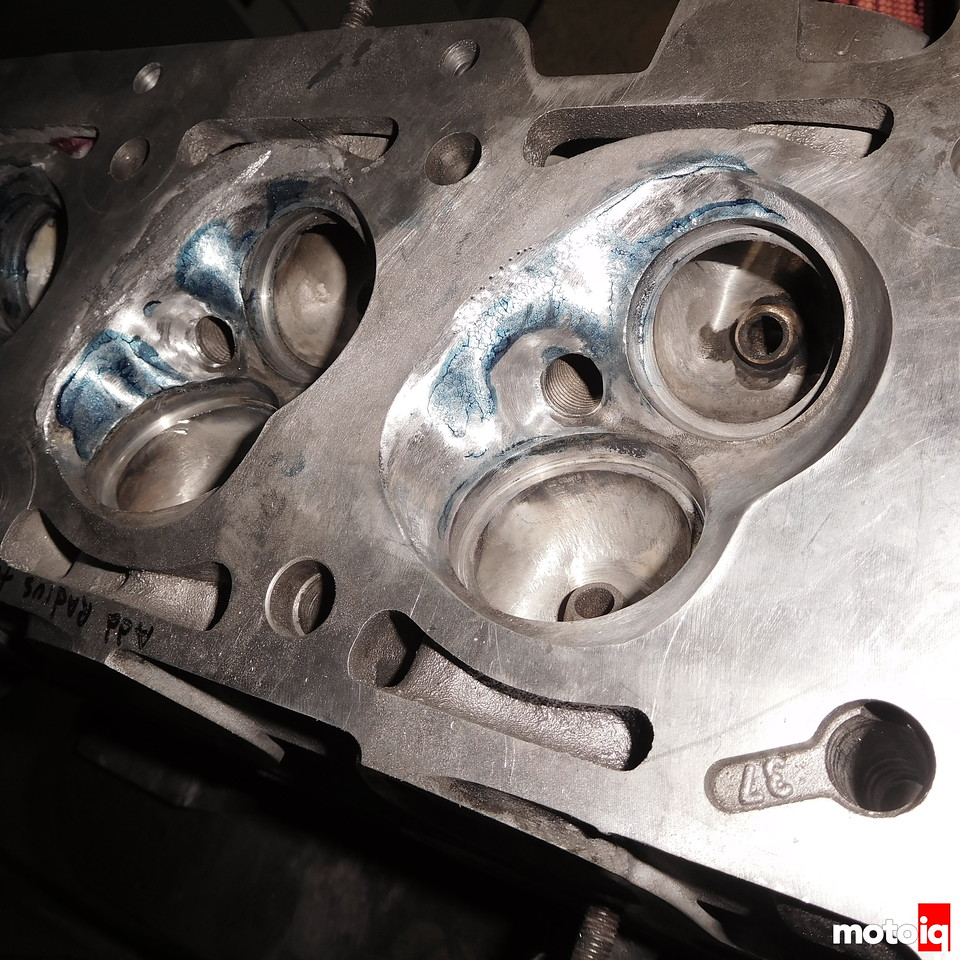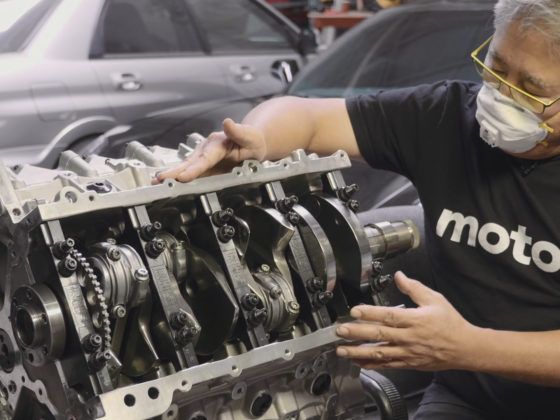The 2002 BMW Flow Test Numbers. All readings are in Cubic Feet Per Minute (CFM) and were recorded on The Fabulous RMI Flow Bench @ 28 inches of water depression.
Intake Port Exhaust Port
Lift Stock RMI Stock RMI
.050 0.0 31.8 36.6 58.2 14.2
.100 34.8 73.5 72.7 58.2 55.2
.150 75.5 101.3 98.3 58.2 88.4
.200 97.5 126.2 130.4 58.2 112.8
.250 128.7 147.6 156.4 88.8 137.4
.300 151.4 164.4 174.9 109.0 154.5
.350 169.4 175.9 187.4 125.5 166.7
.400 181.2 183.7 191.2 137.8 174.8
.450 185.8 187.3 196.2 142.6 177.2
.500 188.6 192.9 202.4 150.3 182.6
.550 190.2 193.3 205.4 155.1 185.2
.600 193.4 196.1 208.1 158.6 191.2
The above numbers are a sampling of the twenty something plus flow bench tests that I ran on this cylinder head. Stock means exactly that. I tested the cylinder head in an “as I received it condition”. There were no changes or adjustments to any part of the cylinder head for Intake or Exhaust ports. The two different numbers on the left under “Stock” are from the same 2002 BMW cylinder head but taken from two different intake ports and cylinders. Interesting no?
It is quite a long way into the actual valve lift before the CFM numbers start to equal each other. Is this unique to this particular cylinder head? No. Do you ever wonder why your engine will run differently from one day to the next? Or why your engine does not measure up to another of the same type and year? Study the two left CFM columns under “Stock”. This is much more “The Norm” than we would like to realize or that manufacturers would like you to be aware of.

Speaking of weirdness. What I have listed as the “Stock” low lift exhaust port flow numbers are correct. The air flow stalled at 58.2 CFM in that port until 0.250” lift. Like Penny Lane, it was very strange.Under actual engine running conditions the exhaust port and charge is experiencing its highest pressure at these lifts. The exhaust charge will of course evacuate. But the stall in the port runner does not help low lift flow and will contribute to additional engine Pumping Losses. This is a negative to engine overall power output. Not a good thing. Re-read the preceding paragraph. As Bill Shakespeare once noted; “There are more things in heaven and earth, Horatio than are dreamt of in your philosophy.” Philosophy in this case refers to Science and Learning.





34 comments
GREAT ARTICLE!!! invaluable insight!! thank you!!
Thank you Wes.
The quench in the combustion chamber will be improved as well as the flow quality lending to better mixture distribution in the cylinder. The BSFC should go down and the engine will probably like less timing. This is somewhat reminiscent of the Soft Head porting and combustion chamber modifications that Larry Widmer did in the 80’s.
Thank you Mike.
Yep, or people like Harry Weslake way before that…. Hemi combustion chambers tend to create low compression on smaller displacement engines. Story of my life, as I tend to mess with them in my spare time. You could actually diffuse mixture from outside the quench area if you make small channels running towards the spark plug. if the quench angle is actually quite steep on a 2 valve with the spark plug on the side. Rounding of the quench also helps a bit. But you should only do that if your can maintain a high enough compression ratio. Otherwise compression should always be leading.
Then again: port angle an radius are a lot more important, but also the stuff where it becomes really tricky. Not so much for grinding, but actually changing the angle and port itself without casting a new head.
Funny you should mention that. I used the same technique in building up my Honda Ruckus Scooter. Had the chamber welded up to make a lot of quench and to bring up the compression ratio to over 13:1. Then I added the channels to the plug because I read some white paper about it. This thing ran really hard for a 50cc scooter, it could go 60 mph with my fat ass on it and I could outrun guys with a 125cc GY6 engine swap. Many other people have tried to follow my lead and build a fast 50cc but no one has come close!
Way to go Don!! You are the Professor of porting.
Thanks love, I’ll cook dinner tonight for that.
Don
Great to see you “un-leashed” in your forte!
Good onya Don, RF.
Thank you Fred, Mister Indian!
That takes an impressive amount of knowledge and determination to modify a cylinder head with such a poor overall performance, and see the significant improvement that was displayed here. Sounds like many hours of work and quite a bit of patience were required, as well. Very interesting article, well written and thoroughly descriptive in content.
Such a cool article, the old school art of hot rodding.
Thank you for sharing!
Thank you Miguel for your nice comment. Old is the optimum word in my particular case.
Stay tuned, there is more coming.
Don
Dear Don,
Many thanks for the article about the 2002 cylinder head modifications. It demonstrated an unusual and innovative approach to gas flow. I was particularly impressed by the test facilities that you have on hand to prove your ideas before putting them to trial as is the traditional suck-it-and- see method. It must save a lot of scrap! Also what is impressive is the outside specialist support that you are able to call upon and your patience and dedication to the project. Sadly for me, you are now going way beyond my own capabilities these days.
Best regards
Bill
Thank you Bill. Nice to know that MotoIQ is making it all the way to England
A well written (and entertaining!) article. Folks with this kind of dedication and who make fast engines. It’s all about brains and sweat.
Thank you Kris
Jackson
Congratulations Don you are The Man.
Great article Don! Wish I had known about Replika Machinen when I was driving my 76 2002. To date one of my favorite cars. As a current customer I appreciate your dedication to the art of air flow and the paramount pursuit of perfection!
Thank you Jeromey
Great article. I am actually about to start on a rebuild project with my 2002 (with x60,000 miles). I won’t be able to to this level work certainly! Any recommendations for shops to do more basic head work in the Bay Area?
Thank you for your comment. We can and do, do less involved cylinder head work. Mike asked me to feature this project as it shows what can be accomplished by people with lots of experience in cylinder head and engine work.
Call me and we can discus your project.
Don
Great article Don! You are a wealth of information. On a side note, Don has been working with us on a new cylinder sleeve design. Stay tuned for more on that.
Thanks Jeff, I guess I better call you!
Good job. It is a good article for those that want to learn.
It is unfortunate that most of the readership do not understand how much work it
is to do the work on the parts and test them AND then generate the words to
explain it to them. I hope they pay you for these efforts.
Regards,
HB2
Thank you Harold for your comments and encouragement.
Don
Don, many people believe that a cylinder head is just a lid with holes for the valves; you’ve proved that it is much, much more.
It was a lot of hard work, but what a good job well done.
Eddie.
Coming from a world class restoration expert like you that is high praise.
Hope you are doing well over there.
Thank you, Don
Thank you Billy.
Three positive comments from over “The Pond”. Spanning the Wide World of Air Flow.
Don
I’m really interested in seeing what kind of numbers the little m10 will put down with that kind of flow improvement..
Thank you PJ.
I am only involved with the cylinder head. At this point what, when and where as far as the rest of the engine goes are a mystery.
Don,
what ‘s and arm wavy cost to do this work AND now that you’ve done all this learning would a 2nd head like this one be cheaper?
I think that you are asking about the price to reproduce this cylinder head. Cheaper???
I have been porting 2 and 4 stroke cylinder heads for over 40 years. What is that life experience and knowledge worth?
It has taken a LOT of work to get to the combustion chamber and the CFM to the point that it is currently.
Will additional “copies” of this cylinder head be less expensive than the original? Possibly, that depends upon the demand.
If you are truly interested then you can call me and we can discuss it.
Don Redmon
Replika Maschinen, Inc
831-359-0863